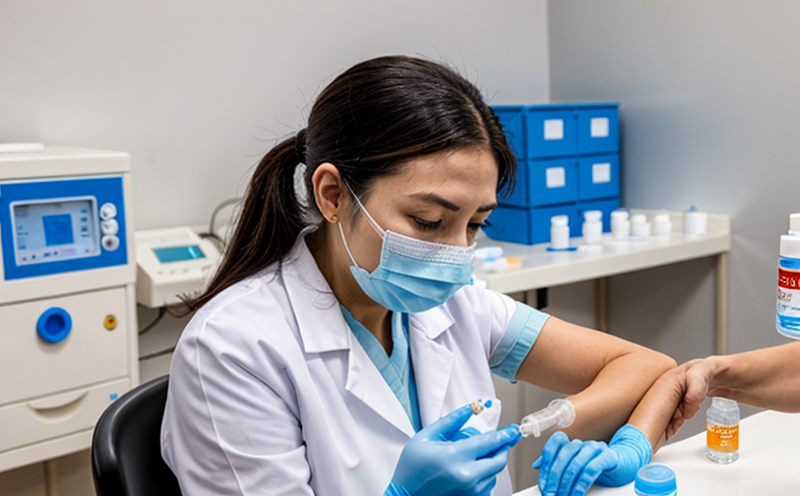USP Residual Formaldehyde Testing in Vaccines
The United States Pharmacopeia (USP) residual formaldehyde test is a critical procedure ensuring vaccines meet stringent safety standards. This testing ensures that vaccines do not contain excessive levels of formaldehyde, which can be harmful if present beyond acceptable limits. In pharmaceuticals, the presence of even trace amounts of formaldehyde may indicate contamination or improper production processes. The USP Ch. <654> provides detailed guidelines for this test, emphasizing the importance of accurate measurement and reporting to guarantee patient safety.
Formaldehyde is a preservative commonly used in vaccine manufacturing to inhibit microbial growth during production. However, once the vaccine is formulated, residual formaldehyde can remain as an impurity. The USP’s stringent limits aim to prevent any potential health risks associated with high exposure levels of this compound. This testing process involves precise sample preparation and analysis using advanced analytical techniques.
The typical procedure includes collecting a representative sample from the vaccine batch, followed by dilution if necessary. Subsequent steps involve derivatization to convert formaldehyde into a more detectable form before quantification via high-performance liquid chromatography (HPLC). The results are compared against the USP’s specified limits, which vary depending on the vaccine type and formulation.
Accurate residual formaldehyde testing is essential for compliance with regulatory requirements. Regulatory bodies like the FDA and EMA enforce strict guidelines to ensure the safety and efficacy of vaccines. Failure to meet these standards can lead to product recalls or withdrawal from the market. Therefore, pharmaceutical manufacturers must adhere strictly to USP Ch. <654>, which includes detailed instructions on sample preparation, chromatographic conditions, detection limits, and acceptable ranges.
The significance of this testing extends beyond mere compliance—it also reflects a commitment to patient safety. By adhering to these stringent tests, pharmaceutical companies can build trust with regulators and the public alike. Additionally, robust quality assurance practices like residual formaldehyde testing enhance brand reputation and market competitiveness in the highly regulated global vaccine industry.
| Applied Standards | Specific Requirements |
|---|---|
| USP Ch. <654> | Guidelines for sample preparation, chromatographic conditions, detection limits, and acceptable ranges. |
| ICH Q7A | International guidelines on good manufacturing practices (GMP) for pharmaceutical products. |
| ISO 14966 | Standards related to biocompatibility of medical devices, which indirectly apply to vaccine safety. |
The USP’s stringent guidelines ensure that vaccines not only comply with regulatory requirements but also meet the highest standards of quality and safety. By adhering strictly to these protocols, pharmaceutical manufacturers can demonstrate their commitment to patient well-being and product integrity.
Applied Standards
- USP Ch. <654>
- ICH Q7A
- ISO 14966
The USP’s Ch. <654> provides detailed guidelines for the residual formaldehyde test, ensuring accurate and consistent results. ICH Q7A focuses on good manufacturing practices (GMP) which are crucial in maintaining high standards during vaccine production. ISO 14966, while primarily focused on medical devices, offers additional insights into biocompatibility that indirectly support vaccine safety.
The USP’s guidelines specify the steps involved in sample preparation and analysis, including dilution methods, derivatization techniques, and chromatographic conditions necessary for detecting residual formaldehyde. These protocols are designed to ensure that even trace amounts of the compound can be detected accurately. Compliance with these standards is essential not only to meet regulatory requirements but also to uphold the integrity of the vaccine manufacturing process.
ICH Q7A emphasizes the importance of GMP in ensuring consistent quality and safety throughout the entire production cycle. By adhering to these guidelines, pharmaceutical manufacturers can minimize the risk of introducing impurities like formaldehyde into their vaccines. ISO 14966, although primarily concerned with medical devices, provides valuable insights into biocompatibility which are pertinent to vaccine development.
International Acceptance and Recognition
- The USP’s residual formaldehyde test is widely accepted globally as a benchmark for ensuring vaccine safety.
- FDA recognizes the USP standards, including Ch. <654>, for compliance with regulatory requirements.
- EMA also adopts USP guidelines to ensure the quality and safety of pharmaceutical products.
- The World Health Organization (WHO) recommends adherence to USP standards as part of its global quality assurance initiatives.
The residual formaldehyde test, as specified in USP Ch. <654>, is recognized internationally for its stringent quality control measures. Regulatory bodies such as the FDA and EMA incorporate these standards into their own guidelines, ensuring consistent application across different regions. The WHO also endorses adherence to USP standards as part of its global initiatives aimed at enhancing vaccine safety and efficacy.
This international recognition underscores the importance of this test in maintaining high standards of quality assurance. By adhering to these globally accepted protocols, pharmaceutical manufacturers can ensure that their vaccines meet rigorous safety criteria, thereby gaining trust from regulatory authorities and consumers alike.
Competitive Advantage and Market Impact
The ability to perform accurate USP residual formaldehyde testing provides a significant competitive advantage in the pharmaceutical industry. This capability ensures that your products consistently meet or exceed regulatory standards, thereby reducing the risk of recalls and product withdrawals.
In today’s highly regulated environment, compliance with international standards is crucial for maintaining market access and reputation. By demonstrating robust quality assurance practices through rigorous testing like residual formaldehyde analysis, you can differentiate yourself from competitors who may not adhere to such stringent protocols.
Moreover, this expertise in quality assurance can enhance your brand’s credibility among stakeholders including regulatory authorities, healthcare providers, and consumers. In an era where transparency about product safety is paramount, being able to showcase compliance with internationally recognized standards like USP Ch. <654> becomes a key differentiator in the market.
The demand for vaccines that meet these high standards continues to grow as public trust in pharmaceuticals strengthens. By investing in this type of testing, you position your company at the forefront of innovation and excellence, paving the way for long-term success in an ever-evolving industry landscape.





